Abstract
Watershed prioritization with the objective of identifying critical areas to undertake soil and water conservation measures was conducted in the upper Han River basin, the water source area of approximately 95,000 km2 for the middle route of China’s South-to-North Water Transfer Project. Based on the estimated soil erosion intensity in uplands and clustering analysis of measured nutrient concentrations in rivers, the basin was grouped into very-high-, high-, moderate-, and low-priority regions for water and soil conservation, respectively. The results indicated that soil erosion was primarily controlled by topography, and nutrients in rivers were associated with land use and land cover in uplands. Also, there was large spatial disparity between soil erosion intensity in the uplands and nutrient concentrations in the rivers across the basin. Analysis was then performed to prioritize the basin by the integration of the soil erosion intensity and water quality on a GIS platform in order to identify critical areas for water and soil conservation in the basin. The identified high-priority regions which occupy 5.74% of the drainage areas need immediate attention for soil and water conservation treatments, of which 5.28% is critical for soil erosion prevention and 0.46% for water conservation. Understandings of the basin environment and pollutant loading with spatial explicit are critical to the soil and water resource conservation for the interbasin water transfer project.





Similar content being viewed by others
References
Baba SMJ, Yusof KW (2001) Modelling soil erosion in tropical environments using remote sensing and geographical informations systems. Hydrologic Sci J 46:191–198
Basnyat P, Teeter LD, Lockaby BG, Flynn FM (2000) The use of remote sensing and GIS in watershed level analysis of non-point source pollution problems. For Ecol Manag 128:65–73
Beckert KA, Fisher TR, O’Neil JM, Jesien RV (2011) Characterization and comparison of stream nutrients, land use, and loading patterns in Maryland Coastal Bay watersheds. Water Air Soil Pollut 221:255–273
Chen J, Gao X, He D, Xia X (2000) Nitrogen contamination in the Yangtze River system, China. J Hazard Mater 73:107–113
Dang H, Jiang M, Zhang Q, Zhang Y (2007) Growth responses of subalpine fir (Abies fargesii) to climate variability in the Qinling Mountain. China. For Ecol Manag 240:143–150
Food and Agricultural Organisation (FAO) (1985) Watershed development with special reference to soil and water conservation. Soil bulletin. Rome, FAO, p 44
Gu S, Cheng X, Shen Z, Zhang Q (2007) Land use/land cover and soil erosion in the upper reaches of Han River basin. Resour Environ Yangtze Basin 16:38–44
Hanson GC, Groffman PM, Gold AJ (1994) Denitrification in riparian wetlands receiving high and low groundwater nitrate inputs. J Environ Qual 23:917–922
Hupp CR, Osterkamp WR (1996) Riparian vegetation and fluvial geomorphic processes. Geomorphology 14:277–295
Jacobs TJ, Gilliam JW (1985) Riparian losses of nitrate from agricultural drainage waters. J Environ Qual 14:472–478
Jain SK, Kumar S, Varghese J (2001) Estimation of soil erosion for Himalayan watershed using GIS technique. Water Resour Manage 15:41–54
Jin R, Guo H (1993) Water resources assessment in the water source areas of the middle route of the South to North Water Transfer Project and water quantity analysis in the Danjiangkou Reservoir. Yangzte River 24:7–12
Kuusemets V, Mander U (2002) Nutrient flows and management of a small watershed. Landsc Ecol 17(Suppl. 1):59–68
Li S, Gu S, Liu W, Han H, Zhang Q (2008) Water quality in relation to the land use and land cover in the Upper Han River basin, China. Catena 75:216–222
Li S, Liu W, Gu S, Cheng X, Xu Z, Zhang Q (2009a) Spatio-temporal dynamics of nutrients in the upper Han River basin, China. J Hazard Mater 162:1340–1346
Li S, Gu S, Tan X, Zhang Q (2009b) Water quality in the upper Han River basin, China: the impacts of land use/land cover in riparian buffer zone. J Hazard Mater 165:317–324
Li S, Zhang Y, Zhang Q (2012) Interaction of landscape setting and stream flow seasonality on nitrogen concentrations in a subtropical river, China. Acta Oecol 44:38–45
Li S, Xia X, Tan X, Zhang Q (2013) Effects of catchment and riparian landscape setting on water chemistry and seasonal evolution of water quality in the Upper Han River Basin, China. PLoS One 8(e53163):1–14
Li S, Ye C, Zhang Q (2017) 11-year change in water chemistry of large freshwater reservoir Dnajiangkou, China. J Hydrol 551:508–517
Liu S, Zhang J, Chen H, Wu Y, Xiong H, Zhang Z (2003) Nutrients in the Changjiang and its tributaries. Biogeochemistry 62:1–18
Liu W, Liu G, Zhang Q (2010) Phosphorus retention capacity of wetland soils from a subtropical reservoir in response to water level fluctuations. Mar Freshw Res 61:507–512
Naiman RJ, Decamps H (1990) The ecology and management of aquatic-terrestrial ecotones. Parthenon Press, UNESCO, Paris
O’Neil JM, Jesien RV, Berkoff J (2003) China: the south–north water transfer project—is it justified. Water Policy 3:1–28
Ocholaa WO, Kerkidesb P (2004) An integrated indicator-based spatial decision support system for land quality assessment in Kenya. Comput Electron Agric 45:3–26
Pandey A, Chowdary VM, Mal BC (2004) Morphological analysis and watershed management using GIS. Hydrol J (India) 27:71–84
Prasad K, Gopi S, Rao SR (1992) Demarcation of priority watersheds in Mahboob Nagar district, A.P. using remote sensing techniques. In: Remote sensing application and GIS, recent trends. Mcgraw-Hill, New Delhi, pp 180–186
Renschler C, Diekkruger B, Mannaerts C (1997) Regionalization in surface runoff and soil erosion risk evaluation in regionalization of hydrology. IAHS Publishers, UK 254: 233–241
Sadeghia SHR, Jalili K, Nikkamib D (2009) Land use optimization in watershed scale. Land Use Policy 26:186–193
Saxena RK, Verma KS, Chary GR, Srivastava R, Barthwal AK (2000) IRS-1C data application in watershed characterization and management. Int J Remote Sens 21:3197–3208
Schnitzler A (1997) River dynamics as a forest process: interaction between fluvial systems and alluvial forests in large European river plains. Bot Rev 63:40–64
Sharda D, Ravi Kumar MV, Venkatatatnam L, Rao M (1993) Watershed prioritization for soil conservation—a GIS approach. Geo Carto Internat 1:27–34
Sharma JC, Prasad J, Saha SK, Pande LM (2001) Watershed prioritization based on sediment yield index in eastern part of Don valley using RS and GIS. Indian J Soil Conserv 29:7–13
Shen Z, Zhang Q, Zhao J, Hu Z, Tang Y, Lu N (2006) The spatial pattern of land use and land cover in the water supplying area of the middle-route of the South-to-North Water Diversion (MP-SNWD) Project. Acta Geograph Sin 61:633–644
The Ministry of Water Resources (MWR) (1997) The standard of soil erosion classification, SL190–96
Yang Y, Zhou N, Guo X, Hu Q (1997) The hydrology characteristics analysis of Han Jiang up-streams. Hydrology 54–56
Zhang Q (2005) The South-to-North Water Transfer Project. Front Ecol Environ 3:75–76
Zhang Q (2009) The South-to-North Water Transfer Project of China, an overview of its environmental implications. J Am Water Resour Assoc 45(5):1238–1247
Zhang P, Shao G, Zhao G, LeMaster DC, Parker GR, Dunning JB Jr, Li Q (2000) China’s forest policy for the 21st century. Science 288:2135–2136
Zhang Q, Devers D, Desch A, Justice CO, Townshend J (2005) Mapping tropical deforestation in Central Africa using Landsat TM imageries. Environ Monit Assess 101:69–83
Zhang Q, Xu Z, Shen Z, Li S, Wang S (2009) The Han River watershed management initiative for the South-to-North Water Transfer Project (middle route) of China. Environ Monit Assess 148:369–377
Funding
The research is supported by a doctoral scholarship.
Author information
Authors and Affiliations
Corresponding author
Additional information
Responsible editor: Philippe Garrigues
Rights and permissions
About this article
Cite this article
Wu, H. Watershed prioritization in the upper Han River basin for soil and water conservation in the South-to-North Water Transfer Project (middle route) of China. Environ Sci Pollut Res 25, 2231–2238 (2018). https://doi.org/10.1007/s11356-017-0675-x
Received:
Accepted:
Published:
Issue Date:
DOI: https://doi.org/10.1007/s11356-017-0675-x




